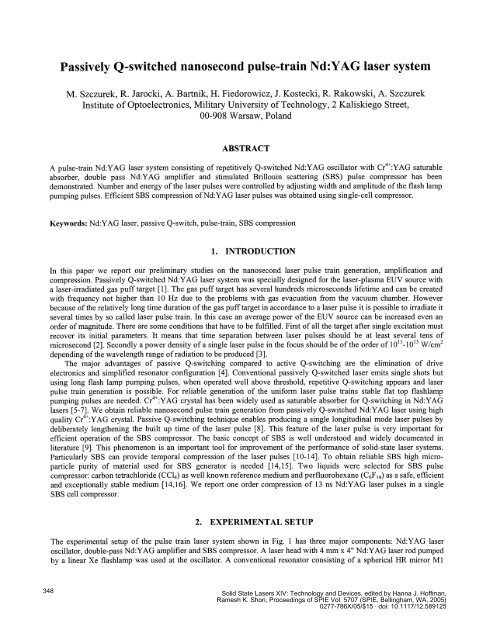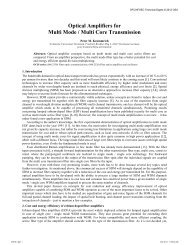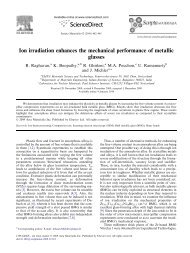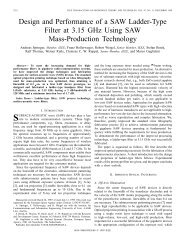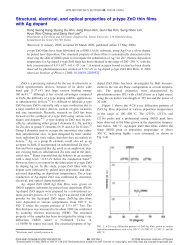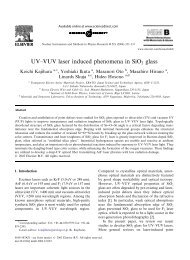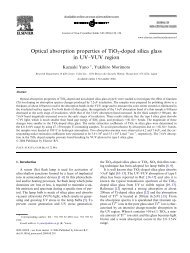Passively Q-switched nanosecond pulse-train Nd:YAG laser system
Passively Q-switched nanosecond pulse-train Nd:YAG laser system
Passively Q-switched nanosecond pulse-train Nd:YAG laser system
Create successful ePaper yourself
Turn your PDF publications into a flip-book with our unique Google optimized e-Paper software.
<strong>Passively</strong> Q-<strong>switched</strong> <strong>nanosecond</strong> <strong>pulse</strong>-<strong>train</strong> <strong>Nd</strong>:<strong>YAG</strong> <strong>laser</strong> <strong>system</strong><br />
M. Szczurek, R. Jarocki, A. Bartnik, H. Fiedorowicz, J. Kostecki, R. Rakowski, A. Szczurek<br />
Institute of Optoelectronics, Military University of Technology, 2 Kaliskiego Street,<br />
00-908 Warsaw, Poland<br />
ABSTRACT<br />
A <strong>pulse</strong>-<strong>train</strong> <strong>Nd</strong>:<strong>YAG</strong> <strong>laser</strong> <strong>system</strong> consisting of repetitively Q-<strong>switched</strong> <strong>Nd</strong>:<strong>YAG</strong> oscillator with Cr4:<strong>YAG</strong> saturable<br />
absorber, double pass <strong>Nd</strong>:<strong>YAG</strong> amplifier and stimulated Brillouin scattering (SBS) <strong>pulse</strong> compressor has been<br />
demonstrated. Number and energy of the <strong>laser</strong> <strong>pulse</strong>s were controlled by adjusting width and amplitude of the flash lamp<br />
pumping <strong>pulse</strong>s. Efficient SBS compression of<strong>Nd</strong>:<strong>YAG</strong> <strong>laser</strong> <strong>pulse</strong>s was obtained using single-cell compressor.<br />
Keywords: <strong>Nd</strong>:<strong>YAG</strong> <strong>laser</strong>, passive Q-switch, <strong>pulse</strong>-<strong>train</strong>, SBS compression<br />
1. INTRODUCTION<br />
In this paper we report our preliminary studies on the <strong>nanosecond</strong> <strong>laser</strong> <strong>pulse</strong> <strong>train</strong> generation, amplification and<br />
compression. <strong>Passively</strong> Q-<strong>switched</strong> <strong>Nd</strong>:<strong>YAG</strong> <strong>laser</strong> <strong>system</strong> was specially designed for the <strong>laser</strong>-plasma EUV source with<br />
a <strong>laser</strong>-irradiated gas puff target [1]. The gas puff target has several hundreds microseconds lifetime and can be created<br />
with frequency not higher than 1 0 Hz due to the problems with gas evacuation from the vacuum chamber. However<br />
because of the relatively long time duration of the gas puff target in accordance to a <strong>laser</strong> <strong>pulse</strong> it is possible to irradiate it<br />
several times by so called <strong>laser</strong> <strong>pulse</strong> <strong>train</strong>. In this case an average power of the EUV source can be increased even an<br />
order of magnitude. There are some conditions that have to be fulfilled. First of all the target after single excitation must<br />
recover its initial parameters. It means that time separation between <strong>laser</strong> <strong>pulse</strong>s should be at least several tens of<br />
microsecond [2]. Secondly a power density ofa single <strong>laser</strong> <strong>pulse</strong> in the focus should be ofthe order of lOh1lO13 W/cm2<br />
depending ofthe wavelength range ofradiation to be produced [3].<br />
The major advantages of passive Q-switching compared to active Q-switching are the elimination of drive<br />
electronics and simplified resonator configuration [4]. Conventional passively Q-<strong>switched</strong> <strong>laser</strong> emits single shots but<br />
using long flash lamp pumping <strong>pulse</strong>s, when operated well above threshold, repetitive Q-switching appears and <strong>laser</strong><br />
<strong>pulse</strong> <strong>train</strong> generation is possible. For reliable generation of the uniform <strong>laser</strong> <strong>pulse</strong> <strong>train</strong>s stable flat top flashlamp<br />
pumping <strong>pulse</strong>s are needed. Cr4:<strong>YAG</strong> crystal has been widely used as saturable absorber for Q-switching in <strong>Nd</strong>:<strong>YAG</strong><br />
<strong>laser</strong>s [5-7]. We obtain reliable <strong>nanosecond</strong> <strong>pulse</strong> <strong>train</strong> generation from passively Q-<strong>switched</strong> <strong>Nd</strong>:<strong>YAG</strong> <strong>laser</strong> using high<br />
quality Cr4:<strong>YAG</strong> crystal. Passive Q-switching technique enables producing a single longitudinal mode <strong>laser</strong> <strong>pulse</strong>s by<br />
deliberately lengthening the built up time of the <strong>laser</strong> <strong>pulse</strong> [8]. This feature of the <strong>laser</strong> <strong>pulse</strong> is very important for<br />
efficient operation of the SBS compressor. The basic concept of SBS is well understood and widely documented in<br />
literature [9]. This phenomenon is an important tool for improvement of the performance of solid-state <strong>laser</strong> <strong>system</strong>s.<br />
Particularly SBS can provide temporal compression of the <strong>laser</strong> <strong>pulse</strong>s [10-14]. To obtain reliable SBS high microparticle<br />
purity of material used for SBS generator is needed [14,15]. Two liquids were selected for SBS <strong>pulse</strong><br />
compressor: carbon tetrachioride (CC14) as well known reference medium and perfluorohexane (C6F14) as a safe, efficient<br />
and exceptionally stable medium [14, 1 6]. We report one order compression of 1 3 ns <strong>Nd</strong>:<strong>YAG</strong> <strong>laser</strong> <strong>pulse</strong>s in a single<br />
SBS cell compressor.<br />
348<br />
2. EXPERIMENTAL SETUP<br />
The experimental setup of the <strong>pulse</strong> <strong>train</strong> <strong>laser</strong> <strong>system</strong> shown in Fig. 1 has three major components: <strong>Nd</strong>:<strong>YAG</strong> <strong>laser</strong><br />
oscillator, double-pass <strong>Nd</strong>:<strong>YAG</strong> amplifier and SBS compressor. A <strong>laser</strong> head with 4 mm x 4" <strong>Nd</strong>:<strong>YAG</strong> <strong>laser</strong> rod pumped<br />
by a linear Xe flashlamp was used at the oscillator. A conventional resonator consisting of a spherical HR mirror Ml<br />
Solid State Lasers XIV: Technology and Devices, edited by Hanna J. Hoffman,<br />
Ramesh K. Shori, Proceedings of SPIE Vol. 5707 (SPIE, Bellingham, WA, 2005)<br />
0277-786X/05/$15 · doi: 10.1117/12.589125
i:i] T''""<br />
:: ;UL_J "H— "'""""<br />
!<br />
1<br />
" :: "I""'":: ::. :<br />
..<br />
"<br />
__ -J<br />
Fig. 1. Experimental setup ofthe <strong>pulse</strong>-<strong>train</strong> <strong>laser</strong> <strong>system</strong>: Ml, M2, resonator mirrors (spherical and flat, respectively); LH, <strong>Nd</strong>:<strong>YAG</strong><br />
<strong>laser</strong> head; DP, dielectric polarizers; SA, saturable absorber (AR coated Cr4:<strong>YAG</strong> crystal); A, aperture; T, telescope; AMP,<br />
<strong>Nd</strong>:<strong>YAG</strong> amplifier; 2/4, retardation plates; HR, high-reflective mirrors; L, AR coated bi-convex lens; SBS, stimulated<br />
Brillouin scattering cell.<br />
and a plane output mirror M2 was passively Q-<strong>switched</strong> by a Cr4:<strong>YAG</strong> saturable absorber with an initial transmission of<br />
25%. After oscillator a Galilean telescope was used. The telescope has two functions: changes the beam diameter by a<br />
factor M=3 and allows for control ofthe <strong>laser</strong> beam divergence. Laser head with 5 mm x 3.5" <strong>Nd</strong>:<strong>YAG</strong> <strong>laser</strong> rod pumped<br />
by a linear Xe flashlamp was used as a double-pass amplifier. A polarization switch consisting of 2/4 retardation plate<br />
and dielectric polarizer was used to extract the <strong>laser</strong> <strong>pulse</strong> after second pass through the amplifier. After amplification a<br />
<strong>laser</strong> <strong>pulse</strong>s were directed to the SBS compressor through 2/2 retardation plate and polarization switch. The beam was<br />
focused with a lens of 70 cm focal length into SBS cell. The SBS cell was a glass tube of 150 cm length containing<br />
perfluorohexane (C6F14) or carbon tetrachioride (Cd4) as reference medium. Laser power supplies with high-current<br />
insulated gate bipolar transistors were used for direct control of the flashlamp current in a microsecond time scale.<br />
Rectangular pumping <strong>pulse</strong>s with variable <strong>pulse</strong> width up to 2 ms were used. The <strong>laser</strong> <strong>system</strong> was operated with<br />
repetition rate 1-10 Hz.<br />
The <strong>laser</strong> <strong>pulse</strong> energy diagnostics were incorporated into the <strong>laser</strong> <strong>system</strong> using uncoated BK-7 beam splitters<br />
and calibrated dual channel energy meter (Laser Precision RJ-7620) with the pyroelectric detectors (RJP-735). The<br />
temporal profiles of the <strong>laser</strong> <strong>pulse</strong>s were recorded using a large area vacuum photodiodes (ITL TF 1 850) coupled to the<br />
digital oscilloscope (Tektronix TDS 620). The time integrated spatial profiles of the <strong>laser</strong> <strong>pulse</strong>s were imaged onto a<br />
CCD camera (Pulnix TM-745) and recorded using <strong>laser</strong> beam analizer (Spiricon LBA 100-A)<br />
3. RESULTS<br />
Temporally smooth, nearly Gaussian-shaped Q-<strong>switched</strong> <strong>pulse</strong>s were achieved owing to the longitudinal-mode selection<br />
properties of the saturable absorber. Typical temporal shape of the <strong>laser</strong> <strong>pulse</strong> is presented in Fig. 2. Very stable 13 ns<br />
<strong>laser</strong> <strong>pulse</strong>s were obtained using short cavity configuration and moderate pumping level to avoid depolarization and<br />
thermal effects. The oscillator was operated at the fundamental transversal mode and near field spatial distribution of the<br />
<strong>laser</strong> beam is presented in Fig. 3. The output <strong>laser</strong> beam was intracavity polarized by a dielectric polarizer for proper<br />
operation of the polarization switches used to extract <strong>laser</strong> <strong>pulse</strong>s at the amplifier and SBS <strong>pulse</strong> compressor <strong>system</strong>s. A<br />
telescope of magnification M=3 was set up for normal adjustment at 632.8 nm with an autocollimator. A correction was<br />
then made for 1064 nm to minimize of a <strong>laser</strong> beam divergence for selected pump and repetition rate using <strong>laser</strong> beam<br />
analizer. The magnification of the telescope was chosen to match the beam profile to the double pass amplifier aperture<br />
and avoid diffraction effects.<br />
Proc. of SPIE Vol. 5707 349
Fig. 2. Temporal shape ofthe oscillator <strong>laser</strong> <strong>pulse</strong>.<br />
Fig. 3. Spatial distribution ofthe oscillator <strong>laser</strong> beam.<br />
Reliable repetitive Q-switching was achieved using stable rectangular flashlamp pumping <strong>pulse</strong>s presented in Fig. 4 a.<br />
Typical <strong>laser</strong> <strong>pulse</strong> <strong>train</strong> is presented in Fig. 4 b. It consists of ten <strong>laser</strong> <strong>pulse</strong>s separated by about 100 ts. Generally the<br />
number of <strong>pulse</strong>s can be controlled by adjusting of the pump energy, the initial transmission of the absorber and the<br />
output coupling of the resonator.<br />
a,<br />
0<br />
) 508<br />
::::<br />
E<br />
7<br />
j<br />
1<br />
20 40 60<br />
Time [nsj<br />
13n FWHM<br />
80 100 120<br />
Fig. 4. a) Temporal shape of the flashlamp pumping <strong>pulse</strong>. b) Temporal structure of a <strong>laser</strong> <strong>pulse</strong> <strong>train</strong>.<br />
350 Proc. of SPIE Vol. 5707<br />
1000 1500<br />
Time ['as]<br />
a)<br />
2000 2580<br />
a,<br />
So<br />
OS<br />
E<br />
03t)<br />
S<br />
:: : :'<br />
200 400 600 800 1000<br />
Time ['as]<br />
b)
In our experiment number of <strong>laser</strong> <strong>pulse</strong>s in the <strong>laser</strong> <strong>pulse</strong> <strong>train</strong> was controlled by changing of the oscillator flashlamp<br />
pumping energy for 1 ms duration of the flashlamp <strong>pulse</strong> to matched with lifetime of the gas puff target. The number of<br />
<strong>laser</strong> <strong>pulse</strong>s as a function of flashlamp pumping energy is shown in Fig. 5.<br />
Q)Cl)<br />
• E<br />
0,4<br />
0,2<br />
0,0<br />
200<br />
400<br />
600<br />
800<br />
1000<br />
Fig. 5. Laser <strong>pulse</strong> <strong>train</strong>s as a function of oscillator pumping energy.<br />
The <strong>laser</strong> <strong>pulse</strong>s creating <strong>train</strong>s shown in Fig. 5 have equal energy and duration (FWHM). Laser <strong>pulse</strong> <strong>train</strong> energy vs.<br />
number of <strong>laser</strong> <strong>pulse</strong>s is shown in Fig. 6.<br />
30<br />
25<br />
20<br />
E 15<br />
a)<br />
w 10<br />
2 4 6 8 10<br />
15<br />
Number of <strong>pulse</strong>s<br />
Fig. 6. Energy ofthe <strong>laser</strong> <strong>pulse</strong> <strong>train</strong> vs. number of <strong>pulse</strong>s.<br />
Low intensity <strong>laser</strong> <strong>pulse</strong>s from the oscillator should be amplified to obtain intensity required for effective EUV and soft<br />
X-ray production (101 1.4013 W/cm2). Assuming 100 tm diameter of the focus we should have 100 mJ of energy for 1 3 ns<br />
<strong>laser</strong> <strong>pulse</strong> to reach power density of lOl 1W/cm2 after focusing of the <strong>laser</strong> beam. To obtain a flat envelope of the<br />
amplified <strong>laser</strong> <strong>pulse</strong> <strong>train</strong> the energy of a single <strong>laser</strong> <strong>pulse</strong> should be chosen in such a way, that depletion of the<br />
inversion caused by the passage of the one <strong>pulse</strong> will be equal to the production of the inversion between two <strong>pulse</strong>s.<br />
Then the inversion will be constant during a <strong>pulse</strong> <strong>train</strong> and each <strong>pulse</strong> will experience the same gain. For fixed oscillator<br />
20<br />
25<br />
30<br />
35<br />
Proc. of SPIE Vol. 5707 351
output energy at the level of about 10 mJ (3 <strong>pulse</strong>s, see Fig. 6), the performance of the double-pass <strong>Nd</strong>:<strong>YAG</strong> amplifier<br />
and SBS compressor was investigated. Laser <strong>pulse</strong> <strong>train</strong> energy of about 240 mJ with 1 Hz repetition rate was obtained.<br />
Full extraction of the energy stored at the amplifier was limited by lack of the sufficient optical isolation of the oscillator<br />
from back-reflected <strong>laser</strong> <strong>pulse</strong>s. Faraday rotators before optical switches should be applied. SBS reflectivity was<br />
investigated as a function of the input energy delivered from the output of double pass <strong>Nd</strong>:<strong>YAG</strong> amplifier. Results of the<br />
measurements are presented in Fig. 7.<br />
0,8<br />
0,7<br />
0,6<br />
0,5<br />
> 0,4<br />
0<br />
a)<br />
0,3 U CF<br />
0,2 A CCI4<br />
0,1<br />
20 40 60 80 100 120 140<br />
Input energy [mJ]<br />
Fig. 7. SBS reflectivity as a function of input energy for two SBS active media: perfluorohexane (C6F14) and carbon tetrachioride<br />
(Cd4). The bars represent the standard deviation obtained from an average of 10 shots for each value of reflectivity.<br />
In general, the limit to the peak power that can be delivered to a SBS <strong>pulse</strong> compressor is determined by competing<br />
processes such as stimulated Raman scattering, self focusing, and optical breakdown. In our experiment an optical<br />
breakdown at the vicinity of the focus due to avalanche ionization of SBS medium initiated by spark on impurities for<br />
input energy higher than 50 mJ was observed. Effective crossection for this process is proportional to the size of the<br />
particle. Decreasing the size and amount of micro-particles gives us the possibility of reducing the generation of free<br />
charge in the liquid necessary for electron avalanche ionization and avoid breakdown [15]. As a result, it is necessary to<br />
remove these micro-particles using closed loop filtration <strong>system</strong> installed on the SBS cell. Such <strong>system</strong> is under<br />
preparation and pressure filter funnel assemblies with removable fritted disc (Aldrich Z422924- 1 EA) and glass<br />
microfibre filters (Whatman Z242543, Z258288) will be applied to retain micro-particles. Ultrafiltration below 0. 1 jtm is<br />
needed [14, 16]. For the input energy less than 50 mJ reliable SBS reflection was observed. Temporal profiles of the<br />
Stokes <strong>pulse</strong>s measured at the output of the SBS compressor are presented in Fig. 8. For Cd4 10 times and for C6F14 8<br />
times compression was obtained.<br />
(I)<br />
C<br />
0V '<br />
0,<br />
E<br />
::<br />
...<br />
352 Proc. of SPIE Vol. 5707<br />
1.2 n&FWHM<br />
.<br />
5 10 15 20 25<br />
Time [nd<br />
a)<br />
Fig. 8. Stokes <strong>pulse</strong>s measured at the output of SBS compressor: a) for CC14 and b) for C6F14.<br />
I<br />
C<br />
C<br />
0,<br />
'0<br />
0.<br />
E<br />
0,10<br />
I<br />
1,6 n&FWHM<br />
___<br />
1<br />
10<br />
Time [no]<br />
b)<br />
15 20 25
3. CONCLUSIONS<br />
In conclusion, we found repetitive passive Q-switching technology using Cr4:<strong>YAG</strong> saturable absorber to be an efficient<br />
method for stable generation of the <strong>nanosecond</strong> <strong>pulse</strong> <strong>train</strong>s. Effective compression of a <strong>laser</strong> <strong>pulse</strong>s was obtained.<br />
Reliable operation of the SBS compressor for the <strong>laser</strong> <strong>pulse</strong> <strong>train</strong> energy higher than 50 mJ requires ultrafiltration of the<br />
SBS active medium. For high efficiency of the EUV and soft X-ray production further amplification of the <strong>laser</strong> <strong>pulse</strong><br />
<strong>train</strong> is needed. It will be realized by applying second double pass <strong>Nd</strong>:<strong>YAG</strong> amplifier at the SBS phase conjugation<br />
scheme.<br />
ACKNOWLEDGEMENTS<br />
The authors wish to thank Z. Mierczyk for providing Cr4:<strong>YAG</strong> saturable absorbers. We are also grateful P. Wachulak<br />
for the technical assistance. This work was supported by the following grants of the Ministry of Scientific Research and<br />
Information Technology ofPoland: No. 3 TO8C 002 27, No. 3 Ti lB 03 i 27 and No. 120/E-4i0/SPB/Eureka/O-13/DWN<br />
727.<br />
REFERENCES<br />
1 . H. Fiedorowicz, A. Bartnik, Z. Patron, P. Parys, ,,X-ray emission from <strong>laser</strong>-irradiated gas puff targets"<br />
Appl.Phys.Lett. 62, 2778 (i993)<br />
2. H. Fiedorowicz, A. Bartnik, M. Szczurek, H. Daido, N. Sakaya, V. Kmetik, Y. Kato, M. Suzuki, M. Matsumura, J.<br />
Tajima, T. Nakayama, T. Wilhein, ,,Investigation of soft x-ray emission from a gas puff target irradiated with a<br />
<strong>Nd</strong>:<strong>YAG</strong> <strong>laser</strong>", Opt. Communications 163, 103 (1999)<br />
3. H. Fiedorowicz, A. Bartnik, H. Daido, I. W. Choi, M. Suzuki, S. Yamagami, "Strong EUV emission from a doublestream<br />
xenon/helium gas pufftarget irradiated with a <strong>Nd</strong>:<strong>YAG</strong> <strong>laser</strong>" Optics Communications 184, 16i (2000)<br />
4. J. J. Degnan, . ,,Optimization . of<strong>Passively</strong> Q-Switched Lasers", IEEE J. Quantum Electron. 31, 1890-1901 (1995)<br />
. 4+ . .<br />
5. Y. Shimony, Z. Burshtein, and Y. Kalisky, ,,Cr :<strong>YAG</strong> as Passive Q-Switch and Brewster Plate in a Pulsed <strong>Nd</strong>:<strong>YAG</strong><br />
Laser" IEEE J. Quantum Electron. 31, 1738-1741 (1995)<br />
6. Y.Shimony, Z. Burshtein, A. B. Baranga, Y. Kalisky, and M. Strauss, ,,Repetitive Q-Switching of a CW <strong>Nd</strong>:<strong>YAG</strong><br />
Laser Using Cr4:<strong>YAG</strong> Saturable Absorbers" IEEE J. Quantum Electron. 32, 305-310 (1996)<br />
7. L. Yuxin, L. Haihe, L. Lihuang, and X. Zhizhan, ,,Active-passive mode-locking using Cr4:<strong>YAG</strong> crystal as saturable<br />
absorber" Opt. Laser Technol. 33, 403-407 (2001)<br />
8. W. Koechner, ,,Solid-State Laser Engineering", Springer Series in Optical Sciences, Springer Verlag, Berlin,<br />
Heidelberg, New York, 1986<br />
9. B.Ya. Zeldovich, N.F. Pilipetsky, and V. V. Shkunov, ,,Principles of Phase Conjugation", Springer Series in Optical<br />
Sciences, Springer Verlag, Berlin, Heidelberg, New York, Tokyo, 1985<br />
1 0. D. T. Hon, ,,Pulse compression by stimulated Brillouin scattering", Opt. Lett. 5, 5 1 6-5 1 8 (1980)<br />
1 1 . M. J. Damzen and M. H. R. Hutchinson, ,,High-efficiency <strong>laser</strong>-<strong>pulse</strong> compression by stimulated Brillouin<br />
scattering", Opt. Lett. 8, 3 1 3-3 1 5 (1983)<br />
12. R. R. Buzyalis, A. S. Dementev, and E. K. Kosenko, ,,Formation of sub<strong>nanosecond</strong> <strong>pulse</strong>s by stimulated Brillouin<br />
scattering ofradiation from a <strong>pulse</strong>-periodic <strong>Nd</strong>:<strong>YAG</strong> <strong>laser</strong>", Soy. J. Quantum Electron. 15, 1335-1337 (1985)<br />
13 . M. Davydov and I. N. Koshevnikova, ,,Laser-<strong>pulse</strong> compression by stimulated Brillouin scattering in liquids", Phys.<br />
Lett. A 127, 345-346 (1988)<br />
14. V. Kmetik, H. Fiedorowicz, A. A. Andreev, K. J. Witte, H. Daido, H. Fujita, M. Nakasuka, and T. Yamanaka,<br />
,,Reliable stimulated Brillouin scattering compression of<strong>Nd</strong>:<strong>YAG</strong> <strong>laser</strong> <strong>pulse</strong>s with liquid fluorocarbon for longtime<br />
operation at 10 Hz" Appl. Opt. 37, 7085-7090 (1998)<br />
15. H. J. Eichler, R. Menzel, R. Sander, B. Smandek, ,,Reflectivity enhancement of stimulated Brillouin scattering<br />
liquids by purification" Opt. Commun. 89, 260-262 (1992)<br />
16. C. B. Dane, L. E. Zapata, W. A. Neuman, M. A. Norton, and L. A. Hackel, ,,Design and Operation of a 150 W Near<br />
Diffraction-Limited Laser Amplifier with SBS Wavefront Correction", IEEE J. Quantum Electron. 31, 148-162<br />
(1995)<br />
Proc. of SPIE Vol. 5707 353


